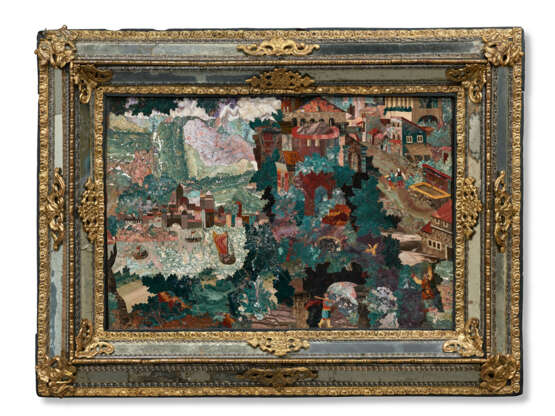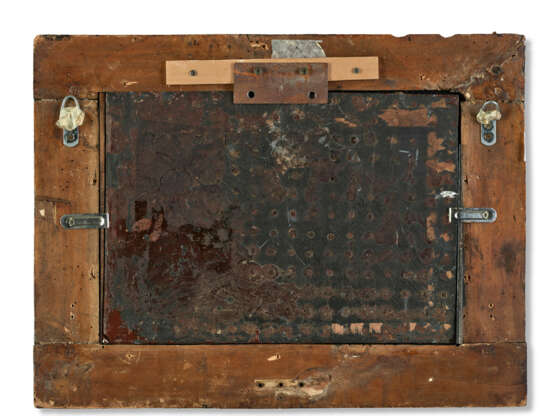ID 1164523
Los 60 | PLAQUE REPRÉSENTANT LA VILLE DE PRAGUE
Schätzwert
€ 150 000 – 250 000
ATTRIBUÉE À COSIMO CASTRUCCI (1536-1636), PRAGUE, VERS 1590-1619
En marqueterie de marbres et de pierres dures, bois fossilisé, cristal de roche, sur fond d'ardoise, le cadre associé à décor de miroir, verre et métal doré
La plaque : 28 x 39 cm. (11 x 15 ½ in.)
Le cadre : 41 x 54,5 cm. (16 x 21 ½ in.)
Provenance
Par tradition Trésor de Rodolphe II, empereur du Saint-Empire romain germanique (1552-1612).
Bernard Steinitz (1933-2012), Biennale des Antiquaires, Paris, 2003.
Collection Jacques Rosenthal, Boulogne.
Vente Sotheby's, Londres, Treasures, 3 juillet 2019, lot 12.
Literature
G. Maugé, Opus Sectile. La marqueterie de pierres dures européenne du XVIe et XIXe siècle, galerie Gismondi, Paris, pp. 8-53.
BIbliographie comparative :
K. Chytil, La couronne de Rodolphe II, Prague 1921, p. 26.
F. Eichler et E. Kris, Die Kameen im Kunsthistorischen Museum in Wien, cat. Kunshistorisches Museum, Vienna, 1929, p. 28.
J. Morávek, Nov ĕ objeven ý inventá ř rudolfinsk ý ch sbírek na Hrad ĕ Pra ž ském, Prague, 1937, p. 11.
E. Neumann, Florentiner Mosaik aus Prag, in Jahrbuch der kunsthistorischen Sammlungen in Wien, LIII, 1957, pp. 157-202.
B. Bukovinská, Dal š í florentské mosaiky z Prah- y, in Um ĕ ni, XX, 1972, pp. 363-370.
L. Bartoli et E. A. Maser, Il Museo dell' Opificio delle pietre dure (...), Florence.
C. W. Fock, Der Goldschmied J. Bylivelt aus Delft und sein Wirken in den Mediceischen Hofwerkstatt in Florenz, in Jahrbuch der Kunsthistorischen Sammlungen in Wien, LXX, 1974.
A. M. Giusti, Pietre Dure. L'arte europea del mosaico negli arredi e nelle decorazioni dal 1500 al 1800, Florence, 1992.
A. M. Massinelli, The Gilbert Collection: Hardstones, cat. Gilbert Collection, Londres, 2000, pp. 29-31.
W. Koeppe et Annamaria Giusti (dir.), Art of the Royal Court: Treasures in Pietre Dure from the Palaces of Europe, cat. exp. Metropolitan Museum of Art, New York, 2008, pp. 219-225, no. 66-69.
Exhibited
Biennale des Antiquaires, galerie Bernard Steinitz, Paris, 2003.
Further details
A PIETRA DURA, ROCK CRYSTAL, FOSSILISED WOOD, MARQUETRY PLAQUE REPRESENTING THE CITY OF PRAGUE, ATTRIBUTED TO COSIMO CASTRUCCI (1536-1636), PRAGUE, CIRCA 1590-1619
In 1583, the Habsburg Emperor Rudolph II (1552-1612) moved his court from Vienna to Prague, the ancient heart of the Bohemian Empire, and established one of the most lively and cosmopolitan artistic centres of Europe. Nine years later, the emperor completed his second prodigious transfer, that of the lapidist Cosimo Castrucci from Florence to Prague, in a move that sought to further enhance the artistic output of the court and help establish a visual identity of his Bohemia.
The ruler first became aware of the art of stone inlay or commesso di pietre dure when in 1589, Grand Duke Ferdinando I de’Medici gifted the emperor a pietra dura tabletop. Following this, Rudolph ordered his own commission which took six and a half years to complete and incorporated stones from Bohemia which he had had sent to Florence. The emperor, however, was not content merely collecting hardstone objects for his famous Kunstkammer but wanted to produce them as well and with the arrival of Castrucci and later his son Giovanni, (d. 1615), the production of pietra dura plaques began to be identified with the city of Prague. Ultimately, the Castrucci family was able to create a new and distinctive style from that of the Florentine pietra dura; the workshop’s compositions informed by the rich artistic environment of the city and their production supported by the hungry demand and generous endowment of their royal patron.
The present panel offers an idealised vision of Prague, identifiable by the Charles Bridge, on the far left-hand side of the plaque, connecting the two banks of the capital. The river scene below infers the city’s bustling port trade and the topography of the foreground closely echoes that of Petřín hill. However, Prague’s normally unspoilt bucolic left bank has been embellished with a scattering of edifices, not just in the traditional Dutch style but equally with an ancient rotunda that more closely follows the Italian tradition. This amalgamation of ancient building and contemporary setting is a recurring theme throughout the commissioned landscapes of Rudolph II’s court artists. The Sovreign granted access to his vast Kunstkammer to encourage local artists and makers to enrich their works with atypical monuments and ancient designs sourced from his collection of drawings, paintings and maps. This practice can be seen in two compositions by Roland Savery (fig. 1) and Pieter Stevens (fig. 2): Savery, in his drawing of the Charles Bridge, includes a depiction of an ancient rotunda sitting high on the luscious hill; in Hendrick Hondius the Younger’s engraving after Stevens, one can observe a large temple structure whose rounded roof is pierced by two windows. Both these iterations of classical forms closely echo the present panel’s construction of the hilltop rotunda, highlighted by a wide orange band in Lorraine jasper. Although we cannot be certain that the plaque was directly informed by Savery and Stevens, the comparison does confirm a consistent visual program that ran throughout the artistic production of Rudolph’s court. The incorporation of these historic structures into the topography of Prague imbues the respective scenes with a sense of mysticism and link the contemporary settings to an ancient past, thus visually elevating Rudolph’s new capital to a center of history and further aligns his present kingdom with the rich legacy of ancient Bohemia.
The distinctive bohemian composition of the panel is equally echoed in the physical make-up and the technical execution. Departing from the Florentine tradition, the dazzling nature of the work is achieved through the highly detailed and delicate interplay of colour. Alongside the traditional Italian marble, several rare stones, including local agates, chalcedonies, jaspers, amethysts, and rock crystal, are incorporated into the composition; an addition that reflected the sovereign’s own passion for the mineral wealth of his kingdom. The graduation and schematic placement of the stones is distinctive specifically to Cosimo Castrucci’s oeuvre, his virtuosity born from his training as a goldsmith. The grouping of earthy greens and browns for the foreground against the hazier pastel colours for the horizon creates a sense of three-dimensionality which further adds to the dreamlike quality of the panel, brought about by the natural incidence of the material. This specific technique lent itself to pastural and rocky landscapes and Cosimo and his workshop produced several scenes of verdant and jagged outcrops for the emperor. Notably Landscape with city view and flaming sky and Landscape with an Obelisk both held in the collections of the Kunsthistorisches Museum in Vienna (inv. nos. Kunstkammer 3039 and 3397), bear striking similarities to the present panel, the variant green marbles and bright inserts of jasper used to form a dynamic countryside with the sharp stone penetrating through the verdant shrubbery. Indeed, the panel manifests as a highly evocative and beautifully executed ode to Rudoph’s vision of Prague, brought to life by the intricate skill of Cosimo Castrucci and his workshop.
| Material: | Marmor, Stein |
|---|---|
| Herkunftsort: | Osteuropa, Tschechien, Italien, Europa |
| Kategorie des Auktionshauses: | Skulpturen, Statuen & Figuren |
| Material: | Marmor, Stein |
|---|---|
| Herkunftsort: | Osteuropa, Tschechien, Italien, Europa |
| Kategorie des Auktionshauses: | Skulpturen, Statuen & Figuren |
| Adresse der Versteigerung |
CHRISTIE'S 9 Avenue Matignon 75008 Paris Frankreich | ||||||||||||||
|---|---|---|---|---|---|---|---|---|---|---|---|---|---|---|---|
| Vorschau |
| ||||||||||||||
| Telefon | +33 (0)1 40 76 85 85 | ||||||||||||||
| Fax | +33 (0)1 40 76 85 86 | ||||||||||||||
| Nutzungsbedingungen | Nutzungsbedingungen | ||||||||||||||
| Versand |
Postdienst Kurierdienst Selbstabholung | ||||||||||||||
| Zahlungsarten |
Banküberweisung | ||||||||||||||
| Geschäftszeiten | Geschäftszeiten
|




